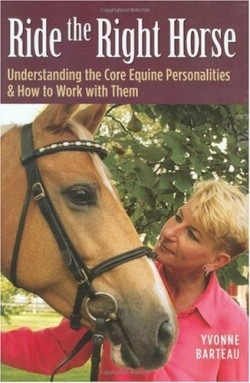
Ride the Right Horse
Understanding the Core Equine Personalities and How to Work with Them
One of Marcel’s front legs was wrapped, and Barteau wondered what had happened to him. When the groom was questioned, it was discovered that there was no injury; the trainer was afraid to work with the horse, so he told everyone Marcel was lame. As the feisty stallion was let out into a pen, fighting with other stallions and rearing up on his hind legs the whole way, it became obvious why: “Definitely not lame, he tore around the stallion pen as if he were auditioning for the equine King Kong,” the author writes.
Marcel is an example of an aggressively challenging horse, which—along with aloof, social, and fearful—is one of the four basic personality types the author has identified through her decades of working with hundreds of horses in the fields of dressage, equine dinner theatre, and racing. Each type can range in intensity from passive to aggressive. Some horses may even exhibit more than one trait, with characteristics of the secondary trait showing themselves most often in stressful situations. Using what she has learned about working with each personality type, Barteau has been able to successfully train many horses that others had given up on, like Marcel.
It is equally important to identify the rider’s own personality and riding type. This will not only facilitate a match with the right horse, but also enable a trainer to develop a program that will be successful for both rider and mount. Barteau lists ten riding types from enthusiastic beginner to focused horseman, and gives an overview of the Myers-Briggs Type Indicator, which she recommends taking to define one’s own personality. Suggestions are offered for which horse personalities will match up best with a rider’s personality and riding type. For example, a well-trained passively social horse is recommended for the cautious beginner because they tend to be friendly and tolerant of beginner mistakes.
This book is a good guide for those just entering the equine world, especially those who are looking to buy their first horse. It is also beneficial to the experienced horseman since it organizes and clearly defines what may already be intuitive, making it a conscious tool that can then be used more effectively. Though at times the writing is repetitive, Barteau does give a thorough explanation of her theories and their practical uses. She includes dozens of case studies, tips for working with weaning and young horses, and profiles of some well-known horsemen, including stunt rider Tommy Turvey, Jr.
Barteau says, “Understanding the temperament of the horse is what sets true horsemen apart from the rest of the riders and horse enthusiasts that comprise the horse world.” This book is a valuable step toward reaching that understanding.
Disclosure: This article is not an endorsement, but a review. The publisher of this book provided free copies of the book to have their book reviewed by a professional reviewer. No fee was paid by the publisher for this review. Foreword Reviews only recommends books that we love. Foreword Magazine, Inc. is disclosing this in accordance with the Federal Trade Commission’s 16 CFR, Part 255.
